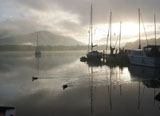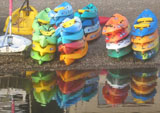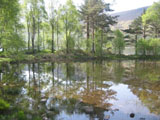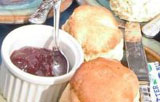|
|
Lake District
Valley and Low-level Walks
Walks near Hawkshead
Hawkshead to Latterbarrow via Fishpond
Wood
3.75 miles [6 km]
The slim monument cairn on the summit of Latterbarrow, northeast of
Hawkshead, can be seen from many of the viewpoints from Langdale to
Kirkstone. It is obviously worth a visit. To make an attractive round walk
from Hawkshead the route begins along what years ago was a public road
from Hawkshead to a ferry crossing of Windermere at Belle Grange. It is a
woodland walk with views and finishes at the open fell at Latterbarrow.
After wet weather bog can be a nuisance in several places and this should
be considered a wellies-boot walk.
Park on the village car park. Leave by the car park main entrance, turn
right to the T junction, then turn left as if you were going to Windermere
via the Ferry. On reaching the first road junction turn left - signposted
to Wray Castle and Wray. You are very soon in the hamlet of Colthouse. The
Quakers were once strongly in evidence about this area and could not have
failed to have had some influence on William Wordsworth's formative years,
as he went to school at Hawkshead. There is a seventeenth century Meeting
House in Colthouse, with an old burial ground. On approaching the hamlet
the slate fence will be noted on the right. There are many of these fences
alongside the fields in this area. At first junction continue left,
through the hamlet, and continue left again. Shortly after this a lane
will be seen leading off to the left. Not many yards beyond this the road
widens on the right. From this a private drive before you leads upwards
from gates. The track required leads from the gate opposite this, directly
on your right, leaving the road at an acute angle.
As you go up this lane a wet patch can be avoided by walking at a higher
level left. There is a good view of the Coniston Old Man range on the
right as you ascend. After a while a stone wall from the right is
approached by a little beck. Go through the gate in the slate fence. There
is a mixed wood on the right. The views are really all behind and you
should stop occasionally to look back. As the wood finishes on the right,
there is an attractive glimpse of Esthwaite Water. Presently a walled
woodland is close to the path, on the left, called Renny Crags Wood, and a
beck is crossed by a footbridge. Fishpond Wood is very soon approached on
the right, and the fishpond can be seen through pine trees. The mud is
difficult to avoid here after wet weather. Left hand side is the best. On
approaching a gate there is another wet section which can be avoided on
the left. As you climb over a brow a sudden view of the High Street range
opens up, and there is a view of the Fairfield range to the left. On
approaching a gate there is another wet section which can be avoided left.
On the other side of this gate there should be a signpost pointing left
for Latterbarrow and right on for Belle Grange and the ferry. You turn
sharp left after going on through this gate. A footpath follows the fence
and wall downwards; take this, keeping the fence to the right. From now
onwards, all the way to Latterbarrow, there should be occasional white
paint marks, as this is part of the way-marked Claife Heights path.
Presently an old wall is seen on the right, and on reaching a gateway in
this, the path turns off to the left to climb a short and very steep bank
to a wall gap by a silver birch tree. Climb this with care and console
yourself with the thought that this is the worst section of the walk.
After emerging through the wall, turn right and follow on. A view of
Windermere lake opens up with a view of Ambleside. The fells behind are
Fairfield and Red Screes, which overlook Kirkstone Pass.
The path turns left before a wall is reached and can be seen fairly well
on the ground. The tall cairn on Latterbarrow is now visible and Langdale
Pikes well behind are glimpsed to its right, curving towards Latterbarrow.
Before reaching a wall turn off to the left to a wall gap. If you have
taken your time it has probably taken an hour to reach this point. The
right of way is to the left of the pine tree, probably indistinct at first
as it passes over drains and wet ground, but more distinct beyond on
higher ground as it curves left. This soon comes to a corner of two deer
fences, and there is a high ladder stile. Climb over this and take the
path on the right which zig-zags through the bracken.
This land is in the care of the National Trust. The cairn is soon seen. It
is an attractive structure crowning an attractive hill. Behind Hawkshead,
which can be seen quite clearly is Grizedale Forest. To the right and
beyond is the Coniston Old Man range. Its highest point is to the left at
2,631 feet. The nearer mass on the range to the right is Wetherlam. To the
right of the Coniston Old Man range there is a tight group of little peaks
known as Crinkle Crags. The highest point is 2,816 feet. Pike o'Blisco is
nearer and to the right. To the right of this is the impressive bulk of
distant Bowfell; highest point is on the left 2,960 feet.
Beyond and to the right of Bowfell can be glimpsed the northern end of the
Scafell Pike range - the highest land in England. This is Great End, a
very popular area for snow and ice climbing in winter. To the right again
is Allen Crags and Glaramara. To the right again is Langdale Pikes and
Pavey Arc, High White Stones and Ullscarf, Armboth Fell (which overlooks
Thirlmere) and before it Helm Crag above Grasmere; Loughrigg Fell, and
behind that through the Dunmail and Thirlmere gap. If visibility allows
there is a glimpse of Skiddaw, almost twenty miles away. Right again is
the southern end of the Helvellyn range - Dollywaggon Pike being the
nearest peak at 2,810 feet. Then there is the Fairfield horseshoe, Red
Screes, and just below this to its right is the summit of Kirkstone Pass,
with its small inn, one of the highest in England, Caudale Moor and the
long north-aligned ridge of High Street follow. The old track of Garbum
Pass is at its nearest end, and behind are the fells at the head of
Kentmere. To the east are the Pennines and the Yorkshire Dales. Right
again, now looking southwards, there are glimpses of Morecambe Bay.
For the best view of Windermere it is
necessary to walk a few yards from the summit cairn, easterly. (That is
the opposite side to Hawkshead.) The head of the lake makes an attractive
picture. Wray Castle is below. To the right of Ambleside is Wansfell, and
the wooded slopes of SkeIghyll. To the right on the lake shore is Low Wood
Hotel. To the right of the picture, on the right of a wood and a group of
buildings is Brockhole, the National Park Centre.
Wander any way down towards Hawkshead as all the little paths link up at
the bottom. It is as well not to take direct line as this leads to a very
steep descent into a hollow. A short diversion to the right is better.
Eventually near the bottom a path will be met descending right. This goes
through alder trees - a tree of wet places. The bog can be avoided in part
by going round to the right on, higher ground. On the other side of the
beck the path is on harder ground. You pass through a gate, and descend
through a field to another gate at the road side.
Turn left along the road. A short way along this road take the right
turning at the junction to walk along a narrow surfaced road by hedges and
slate fences. On reaching a farm - High Loanthwaite Farm - turn left
through the little concrete yard and go through the gate. It could be
muddy here for a short section. Go forward across the fields by the
footpath. It descends with a hedge on the left and through a gate by an
ash tree. It continues to descend, rather less distinct, alongside a
fence, to a wicket gate by an oak tree. Through this gate join the lane
and turn left, and after fifty yards turn right through the slate stile.
Go across the field, bearing slightly left, towards the bottom of a wall
where another slate stile will be seen. Go forward across the field,
keeping the boggy area nearby, to the right. Very shortly go through the
slate stile by the side of a small section of wall on the right. Cross the
drain in the next field by a bridge. Bear slightly left to cross field.
Make it a wide curve left to follow the higher land if the field is boggy,
then right. Make for a slate stile to the left of a group of trees. It is
approached by a short slate bridge over a drain. Go forward towards
Hawkshead village to a fence and bear left to follow it. At the end of it
go through the gate onto the footbridge, and follow the path onto the
village centre.
Hawkshead Moor [Grizedale
Forest]
4.5 miles [7 km]
This is a forest walk. The
walk begins at Hawkshead. Park the car at Hawkshead Car Park. Leave the
car park at the entrance to the village and cross the road towards the
church. Go through the iron gate. The Grammar School, where William
Wordsworth was educated, is on the right. Go through the iron wicket gate
into the churchyard. At path junction in the churchyard turn left. Leave
by the iron wicket gate, and continue on footpath with the slate fence on
the right. Go through wooden wicket gate and at Y junction turn right.
This path shortly turns right through another wooden wicket gate, follows
a wall, then goes through an iron kissing-gate. Go along path between wall
and slate fence to an access road. Continue on to a T junction, turn left.
Pass through an old stone gateway and up past the buildings. Track then
changes to a footpath and goes upwards between fences in open woodland.
The path is joined by a beck, and it is hard to decide which is path and
which beck. It then bears left and climbs upwards through blackthorn
scrub. Path comes to wooden gate which is the boundary of Grizedale
Forest.
Curve left and continue climbing parallel with fence on the left. Cross
the beck, left, and continue climbing with fence. Beech have been planted
alongside the wood. Farther on the beeches can be seen to have been
damaged by browsing deer, and probably sheep too. At the forest road turn
left. Quite shortly after this a ride will be seen on the right of the
road, following an old broken wall. This is the right of way. Turn right
and follow the footpath. A forest road crosses the path eventually, and
there is a forest road opposite. This is the way to go until you get to a
road junction, where you continue left. The road falls and comes to a T
junction. Turn right. And at the junction very shortly afterwards, bear
left, and down the hill. Very shortly again, a beck comes down from the
right and goes under the road through a culvert. just after this there is
a ride on the left. It should have a yellow and red marker on it and this
is the way to go. From now on the yellow and red markers mark your way.
Go down the ride which becomes
a road. Not very far along this road, at a point just before the road
widens out where there is a loading bay for timber, there is a yellow and
red marked path down to the left through the trees alongside a beck. It
starts down the steep bank. Go down with care and follow it. Follow the
path down with the beck, and when the forest closes in left, cross the
beck. This leads on to a forest road, turn left. The road is joined by
others from the right, but continue straight on. After this there is a
fox-proof fence and a tarn where wildfowl are raised. This is Juniper
Tarn.
The road is joined by one from the left. Continue on. There is another
road in from the left and, continuing on, you come to a cattle-grid and
the way out of the forest. At the public road turn right. After sixty
yards turn left through wicket gate. This track could now have white
markers on it. Continue on down this track to the farm buildings of High
Barn. Go through gate and down to a wooden gate at the end of the
buildings. Continue on this line, and follow the ridge of an old hedge
line bearing left. Soon on the left is a hollow. To avoid the wetness near
the gate ahead, it is recommended that this hollow be circled, and at the
far end the fence and wall followed down to the gate. Go through gateway
and continue on the same line, wall on fight. Drop down to track on the
right. Go along on a ridge between two becks. After crossing the
right-hand stream, which is culverted under the path, the path curves
right and then left, and descends to a corner where it is crossed by a
beck. Go on then through the gate and along a good track through woodland.
The beck is in a ravine below. The track crosses the beck at the bottom
and goes through a farmyard. Go between the buildings, join the public
road, and turn left.
Even a minor road such as this one can be unpleasant for walkers, and a
public footpath which follows the road direction at higher level on the
left is recommended. Watch for the lane on the left which should be
signposted. This is How Farm. Turn left. JJust before the gable end of the
building on the right, tum right. Go through a gate and, at the end of the
building, turn left through another gate and, then right to follow the
wall. There is an iron wicket gate at the end. Cross the slate bridge and
turn left up the driveway. Continue along access road through buildings.
join the public road and turn right. Shortly after this watch for public
footpath between walls on the left. This is a pleasant hard-surfaced
footpath. After two kissing-gates and a wooden gate, the tower of
Hawkshead church can be seen ahead. Go through wooden gate, and then the
iron gate of the churchyard. Turn right at the path junction and go past
the Grammar School again.
Heights of Claife, Wise Een and Moss Eccles
4.5 miles [7 km]
This is a very varied walk, through woodland
which is almost jungle in places; out onto high vantage points; and
alongside the quiet waters of two lovely tarns. Following rain, and
possibly forestry operations, this can be a very wet wellies walk. Allow
at least three hours of walking time. There is the chance of seeing wild
deer, both the red deer, Britain's largest mammal, and the roe (the small
dainty deer). Both are more easily seen in winter, but there is a chance
at any time. The signs of both include tracks in soft ground and the
stripping of bark on young trees. These are certain to be seen.
The walk starts at Far Sawrey. This is the first hamlet one comes to after
crossing the ferry from Windermere en route to Hawkshead; and from
Hawkshead towards the ferry it is the second hamlet; Near Sawrey coming
first (being nearer to Hawkshead) and Far Sawrey shortly afterwards. Find
somewhere to park in Far Sawrey without obstructing entrances or gates. A
telephone box will be seen by the Sawrey Hotel, and alongside it is a lane
leading uphill beyond and above the hotel. Go up this, go through the
gate, and just beyond it take the fork right. Look left for a view of the
Sawreys. This is 'Peter Rabbit' country, for Beatrix Potter, creator of
this great character of literature, with Tom Kitten, Jemima Puddleduck and
others, lived at Near Sawrey.
Near the top of the hill note the 'hog-hole' in the stone wall on the
left, to allow sheep access to both sides while retaining the cattle. At
the top of the hill go through the gate, and then take the lane between
the walls on the left. There should be a signpost here directing us
towards Hawkshead. From this point onwards too there should also be white
paint markers, as this is part of the Claife Heights route.
Shortly afterwards the track opens up and wall is on right and a pond or
wet area is passed. The track then goes through a gateway and between wall
and fence with plantations on both sides. The way then opens up and a brow
of a hill is reached with a view of Langdale Pikes left. The right-hand
fork is taken here. Follow it with wall on right, ignoring turnings
through gateways. Track becomes a path.
The path again presently passes between double walls, the left hand one
tumbledown, and a stile is reached, below a shattered tree-clothed crag.
Go over the stile, and the path will be seen going left, zig-zagging up
the hill. This is short and steep. Near the top, watch for the sign-post.
The route from this past goes left, and there should be white markers; but
first go right, if you wish, to a fair view-point. NB. If path begins to
go downhill you have passed the junction by a long way!
Having turned left at this junction you pass between trees over rocky
ground. After a while the path rises under what could best be described as
a tunnel of sitka spruce. It leaves it for a short distance on a left-hand
diversion. Watch out for a turn right, up a crag, very shortly afterwards.
This is Low Pate Crag. Here is an airy place to rest. There are views
across Windermere to the east, soft rounded slopes of the southern
Furness, and to the west the Furness and the Cumbrian fells.
The way off the crag goes right down another green tunnel to a second
crag; High Pate Crag, more set about by trees.
The path from this crag plunges right and down by rocky steps, through a
short tree tunnel, crosses a drain, and climbs through another tunnel
bearing right, and meanders. Before it again goes downwards there is a
crag to the right worth investigating. Nearby stands a triangulation point
erected by Ordnance Survey. This is High Blind How. Go downwards under the
tree tunnel until an apparent T junction is reached. Turn left and along a
wider forest track. Afterwards a forest road is joined at a T junction.
Turn right, along it, for only a short distance. (Note the artificial tarn
on left.) After about ninety yards the path. leaves the road on the left
(watch for waymarks) and goes upwards through the larch trees, changing to
sitkas near the top. The path again opens and falls to cross a drain, then
bearing slightly left, ascends through another short tree tunnel on rock
steps before opening up onto another small larch-clad crag.
The path then bears left, then right through a wet section with a
tumble-down wall on the left. The path afterwards goes left to descend
onto a forest road. The path goes to left here with the waymarks, on a
path which meanders through the trees, parallel with a wet moss on its
right. The path then joins a hard forest road at an elbow. Strictly
speaking from this point one should go 120 yards to the right to join the
right of way, then turn left. However the forest road, left, cuts the
corner.
The white-marked trail has now been abandoned and the track is now an old
bridle-way through a more mature forest. It soon bends left and there is a
pool on the left. The trail now could well be very muddy as it is often
used by horses and tractors, but the mud can be avoided by taking it to
the right.
Leave the forest at last through a gate and follow the wall down for a
short distance to pick up a faint green path going to the right of the
first tarn which is seen ahead. Keep close to the dam to avoid wetness.
The tarn on the right is Wise Een (private). The path now becomes a track
and passes through a gate which should be closed. Follow this track down
to Moss Eccles Tarn.
The track is from then on more distinct, passing through a gate and
between walls. Two tracks join from the right. Then in an area where walls
and fences widen out, and there is a glimpse of a white house across the
field left, there is a Y junction. There is a wooden signpost just before
it. Take the left-hand track signposted 'Bridleway Far Sawrey'. The track
is a green one and is well defined. It goes down through a gate and is
joined by a beck from the left which it presently crosses by a plank
bridge. A macadam track, Cuckoo Brow Lane, is joined. This passes by
several buildings to join a public road by the vicarage, and eventually
the main Hawkshead-ferry road. The starting point at Sawrey Hotel is to
the left.
|
 |



